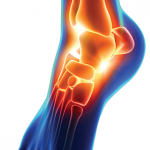She emphasized that both total ankle replacement and arthrodesis are good options, and she counsels her patients about the pros and cons of each.
Hind- & Forefoot
Regarding the hindfoot, Dr. Williams said that arthrodesis is the mainstay of treatment to correct a valgus deformity or involvement of the talonavicular, subtalar and calcaneocuboid joints. To determine the area most affected, she often uses computed tomography- or fluoroscopic-guided anesthetic injections.
During the question-and-answer section, she underscored the importance of using image-guided injections to determine the most painful joints to address surgically because it is not reasonable to fuse every joint in the foot. She also emphasized the need to counsel patients that they will not have complete pain relief after the fusion, but that they can expect the level of pain relief to be similar to what they feel an hour after receiving the anesthetic-guided injection.
To treat the forefoot, Dr. Williams said surgical approaches are changing, particularly for the hallux metatarsophalangeal (MTP) joint. Although arthrodesis remains the standard for the halux MTP joint, she said that joint preservation for the lesser halux MTP joint is becoming a bit more accepted.
Mary Beth Nierengarten is a freelance medical journalist based in Minneapolis.
Reference
- Anastasio AT, Patel PS, Farley KX, et al. Total ankle arthroplasty and ankle arthrodesis in rheumatic disease patients: An analysis of outcomes and complications using the National Inpatient Sample (NIS) Database. Foot Ankle Surg. 2021 Apr;27(3):321–325.

